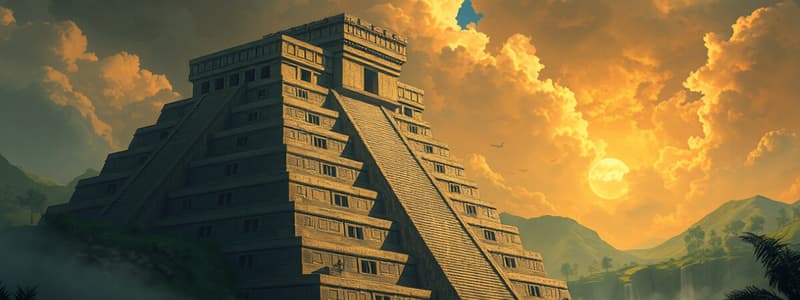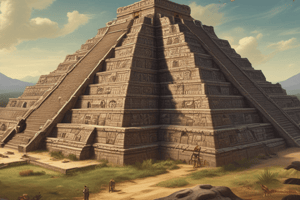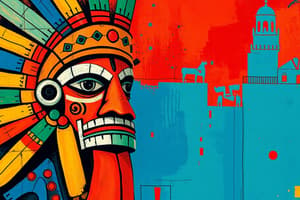Podcast
Questions and Answers
What sign did the Mexica priests look for to know where to settle?
What sign did the Mexica priests look for to know where to settle?
- A turtle crossing a path
- A bear standing by a river
- An eagle perched on a cactus with a snake (correct)
- A hawk flying over the mountains
What was the size of the city of Tenochtitlan when it was fully built?
What was the size of the city of Tenochtitlan when it was fully built?
- 5 square miles (correct)
- 20 square miles
- 2 square miles
- 10 square miles
What method did the Mexica use to expand the size of Tenochtitlan?
What method did the Mexica use to expand the size of Tenochtitlan?
- Creating floating islands called chinampas (correct)
- Damming the lakes to create new land
- Constructing bridges made of stone
- Building tall pyramids around the city
Which of the following conditions did the Mexica need to consider while building Tenochtitlan?
Which of the following conditions did the Mexica need to consider while building Tenochtitlan?
What was the primary reason for the Mexica leaving Aztlan?
What was the primary reason for the Mexica leaving Aztlan?
What was a significant architectural feature of Tenochtitlan that reflected its religious importance?
What was a significant architectural feature of Tenochtitlan that reflected its religious importance?
What geographical feature was crucial for the transportation of goods in Tenochtitlan?
What geographical feature was crucial for the transportation of goods in Tenochtitlan?
In what year was Tenochtitlan founded?
In what year was Tenochtitlan founded?
What event led to the end of the Aztec civilization?
What event led to the end of the Aztec civilization?
Which modern city was built over the ruins of Tenochtitlan?
Which modern city was built over the ruins of Tenochtitlan?
Flashcards are hidden until you start studying
Study Notes
The Origin of the Aztecs
- The Mexica people originated from Aztlan before migrating to Anáhuac in Mesoamerica.
- Huitzilopochtli, their most important god, instructed them through priests to seek a new settlement.
- They were to establish their city upon witnessing an eagle eating a snake on a cactus.
Journey and Settlement
- The Mexica journeyed through dense jungles and encountered five interconnected lakes.
- Initially disappointed at four lakes, they finally spotted the divine sign at Lake Texcoco.
- Tenochtitlan was founded on an island within Lake Texcoco, constructed on two islands using floating chinampas.
City Structure and Technological Achievements
- Tenochtitlan eventually spanned over 5 square miles, showcasing advanced engineering.
- Canals allowed for effective transportation of goods and created a symmetrical city layout.
- Large walkways were built to separate saltwater from freshwater, protecting their structures.
Cultural and Religious Significance
- The Aztecs, who called themselves Culhua-Mexica, placed immense importance on religion, building temples for worship.
- The city was designed with four sections, each divided by canals, reflecting their structured society.
Historical Context
- Tenochtitlan was established around 1325 CE and thrived until its siege by Hernan Cortés and Spanish forces in 1521.
- After 93 days of resistance, the Aztecs surrendered, leading to the collapse of their civilization.
- Mexico City, the modern capital, is built on the original site of Tenochtitlan, with some ancient remnants still visible.
Modern Recognition
- The Mexican flag features the eagle, cactus, and snake symbolizing the Aztec founding myth.
Studying That Suits You
Use AI to generate personalized quizzes and flashcards to suit your learning preferences.




